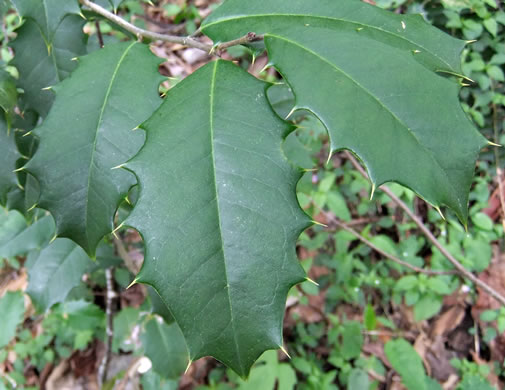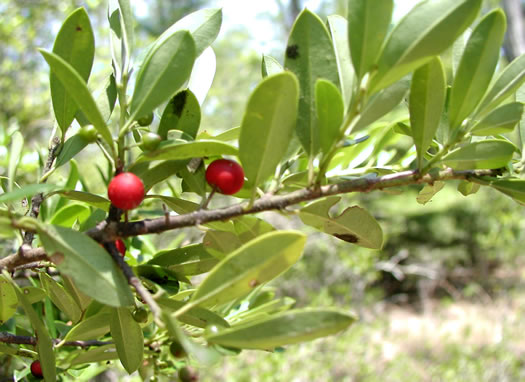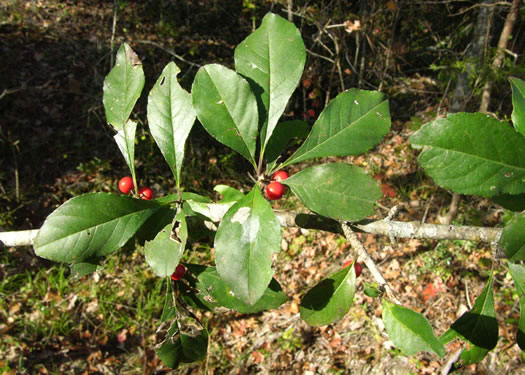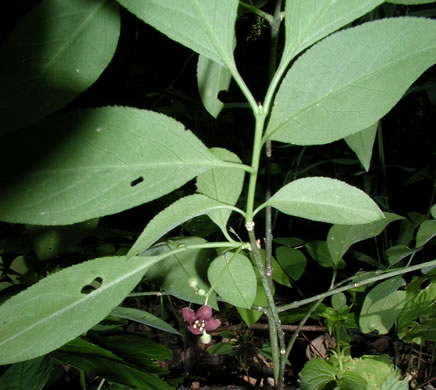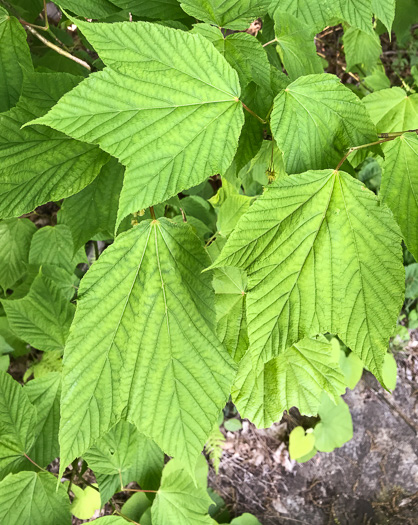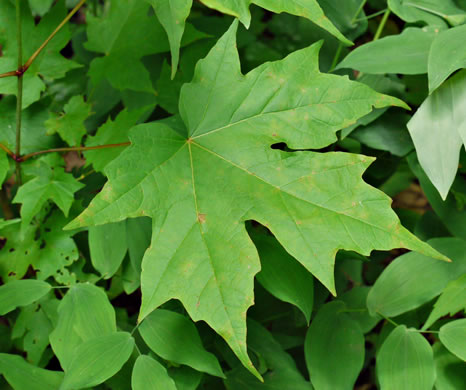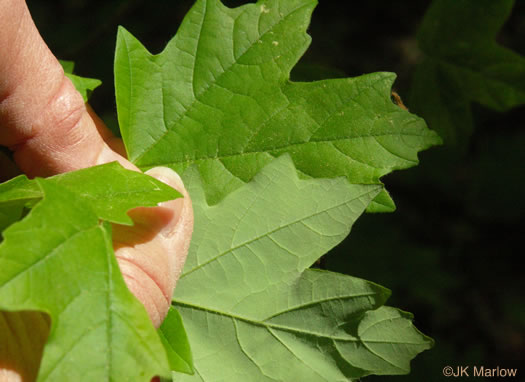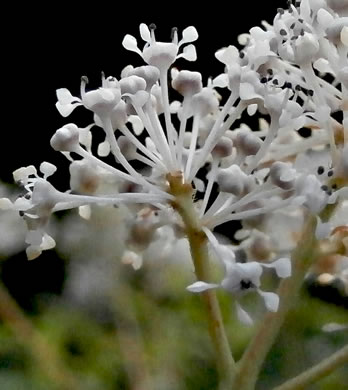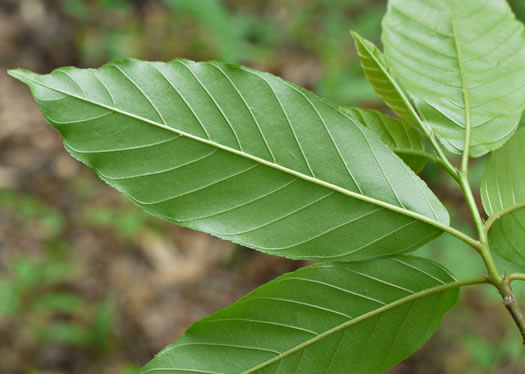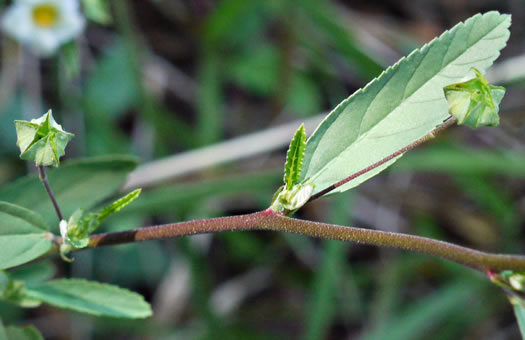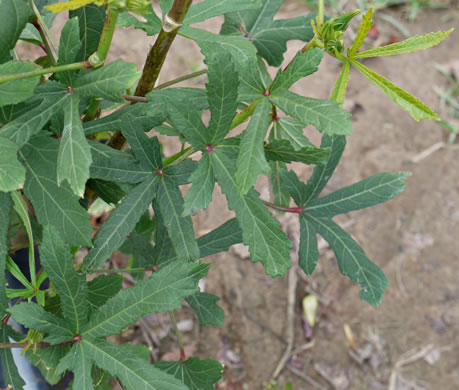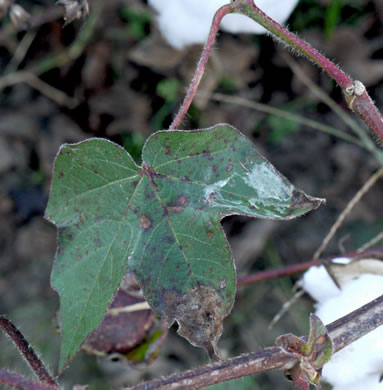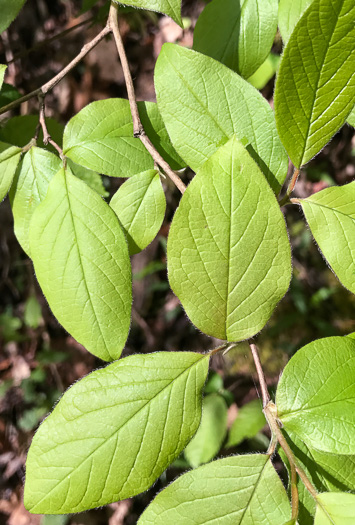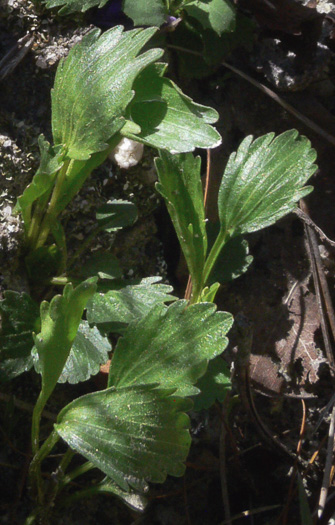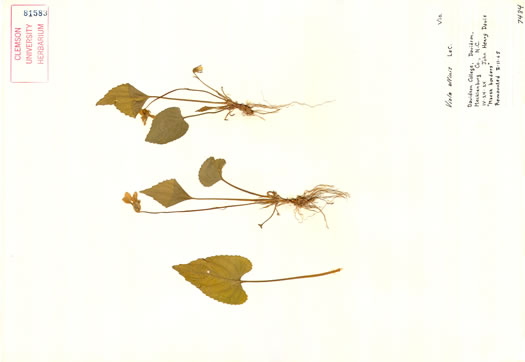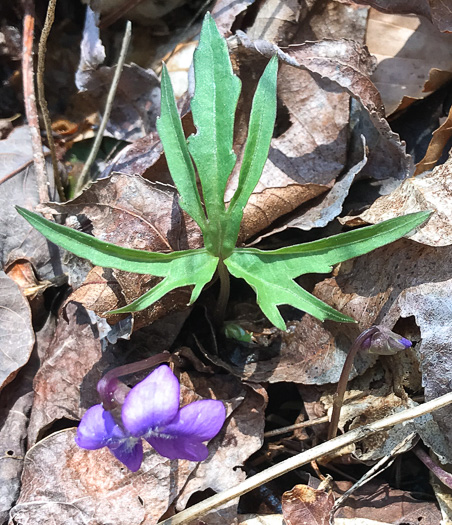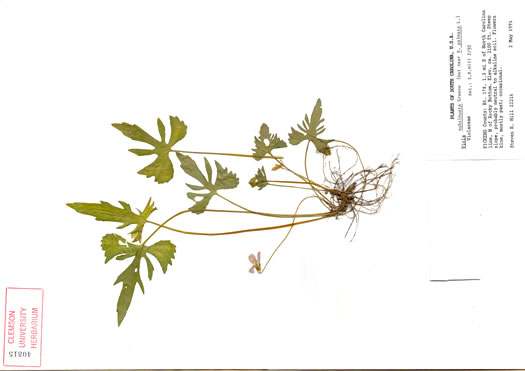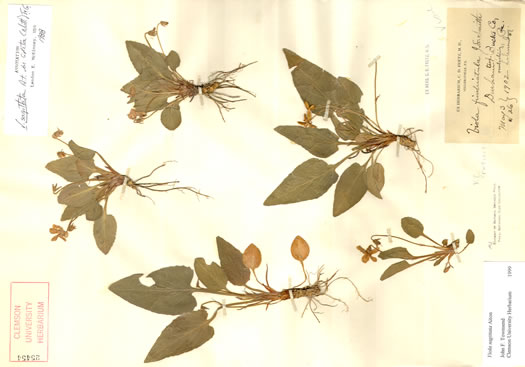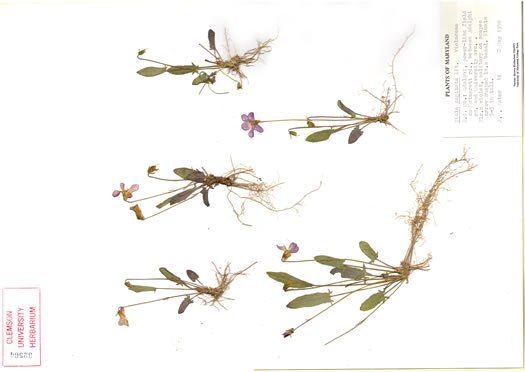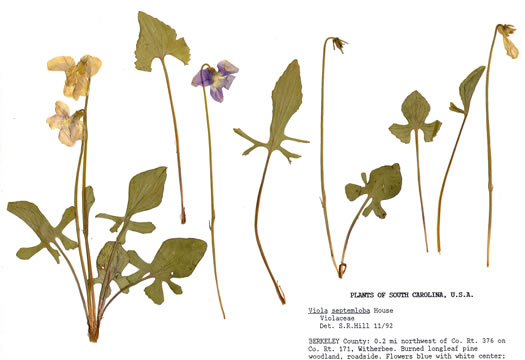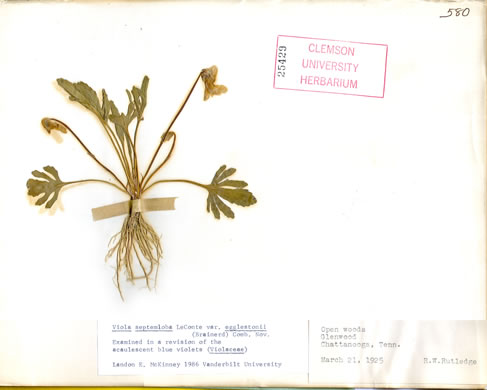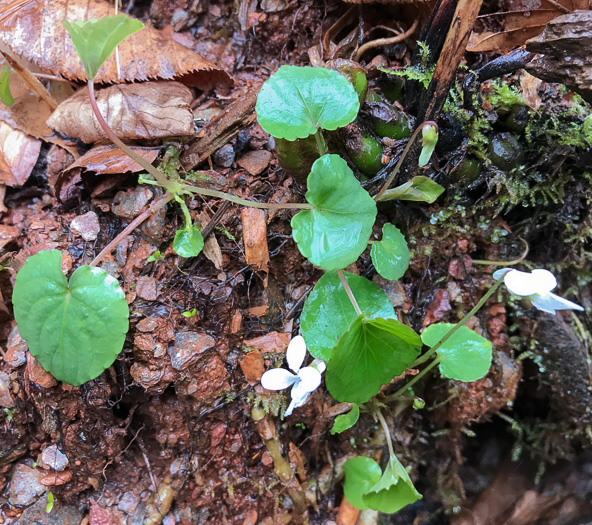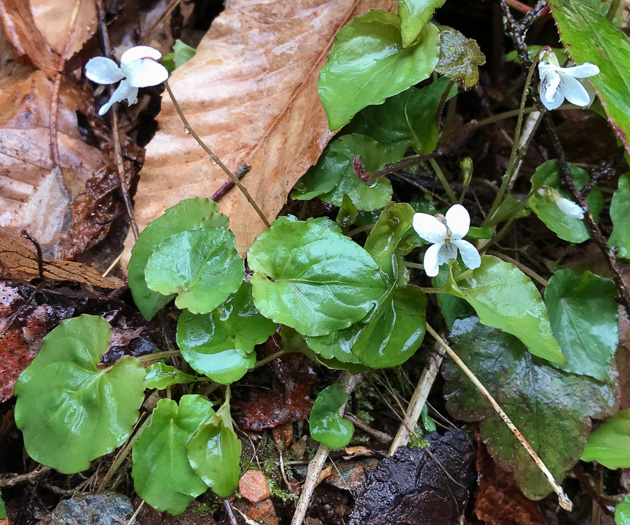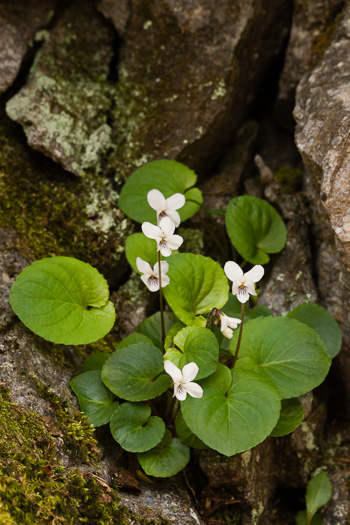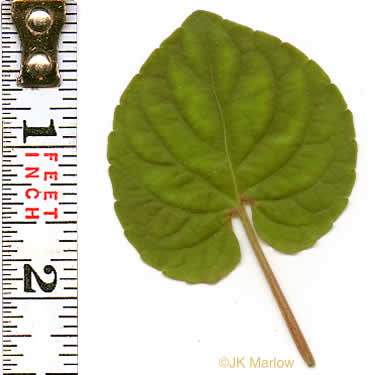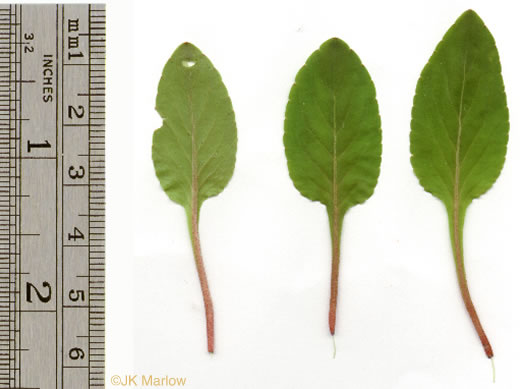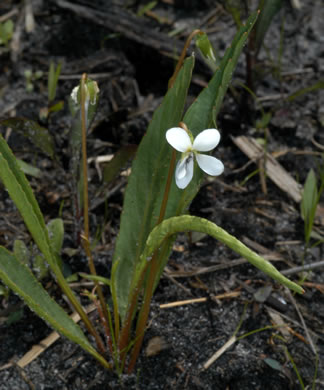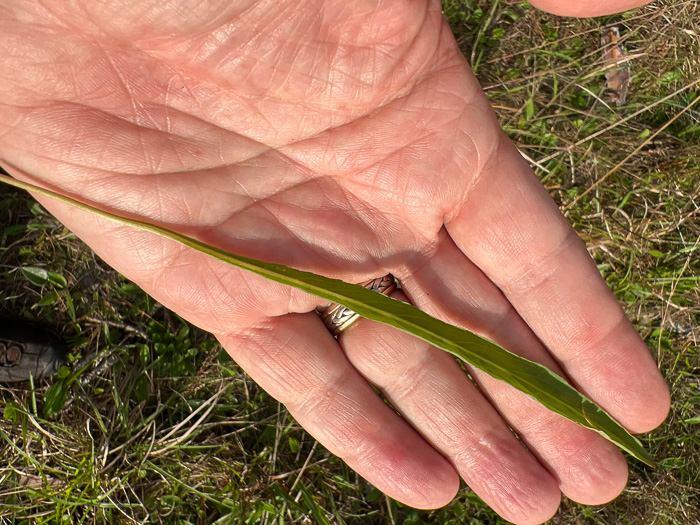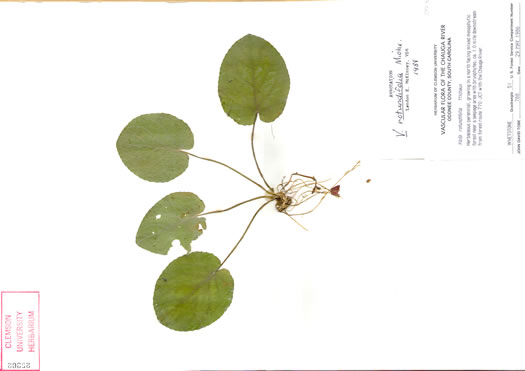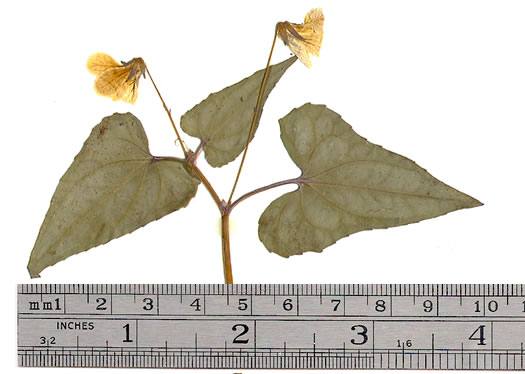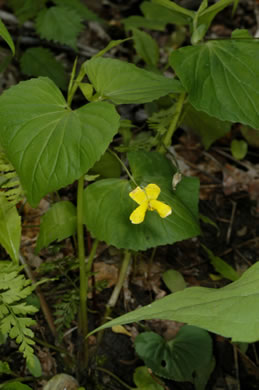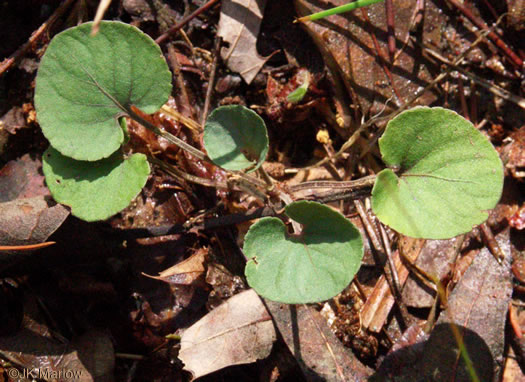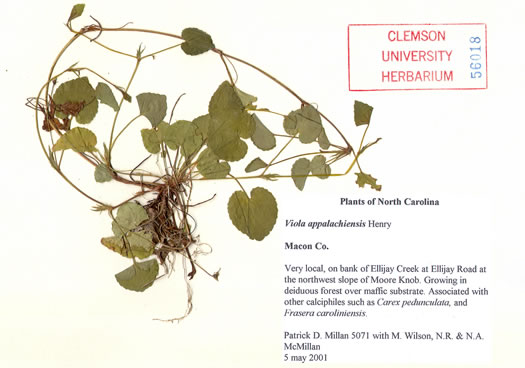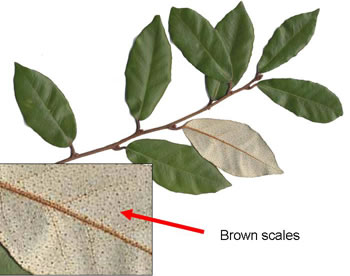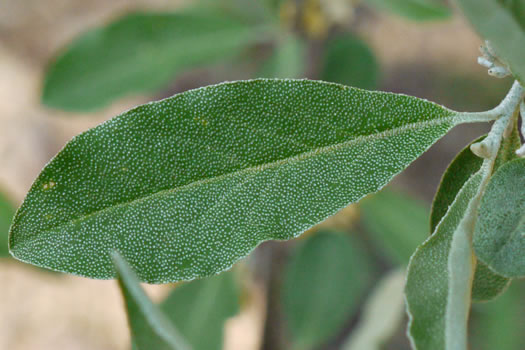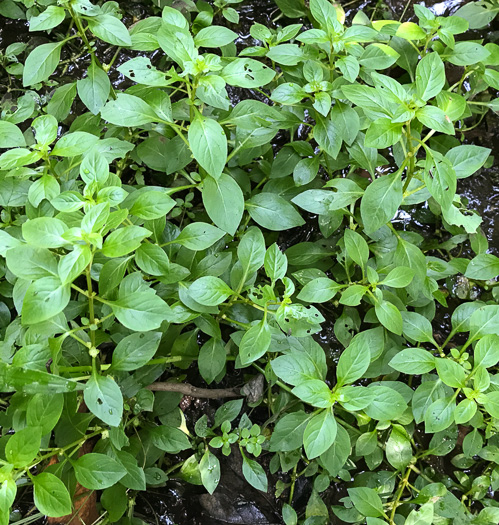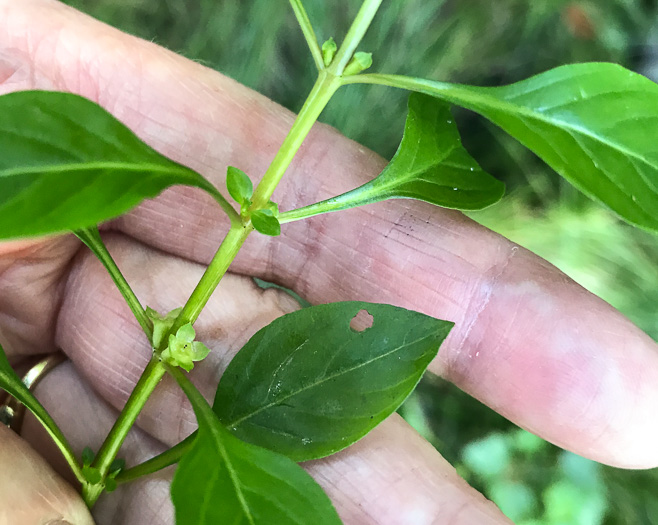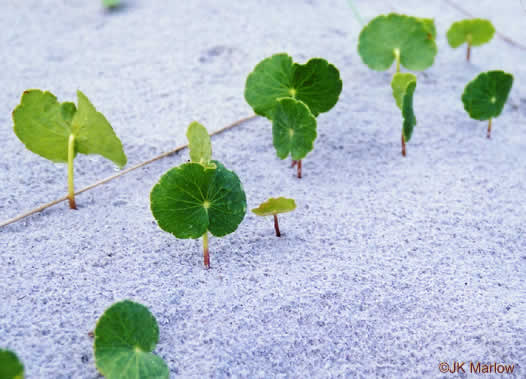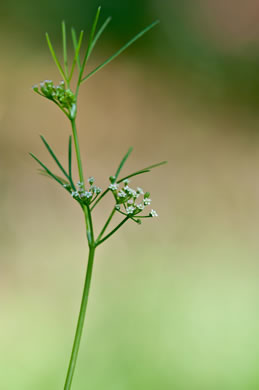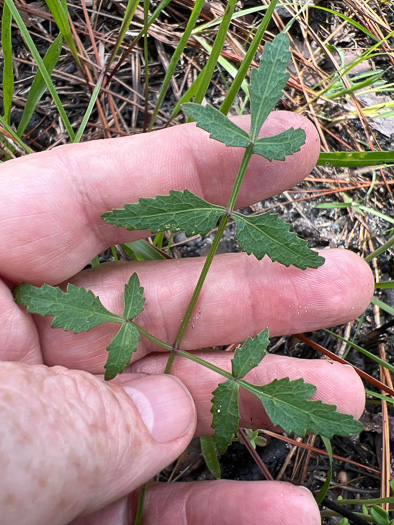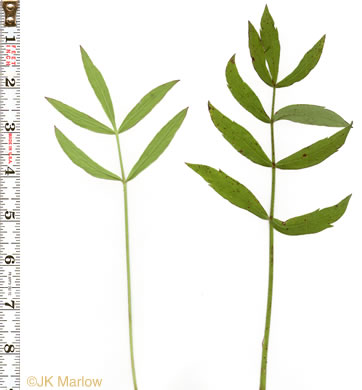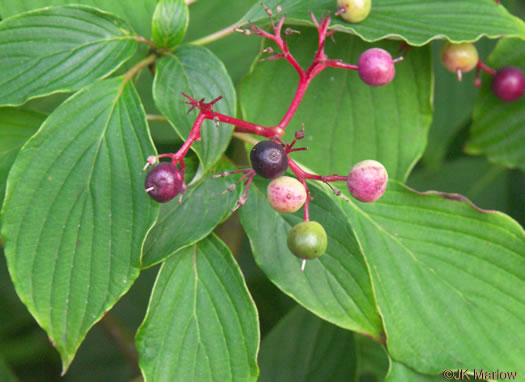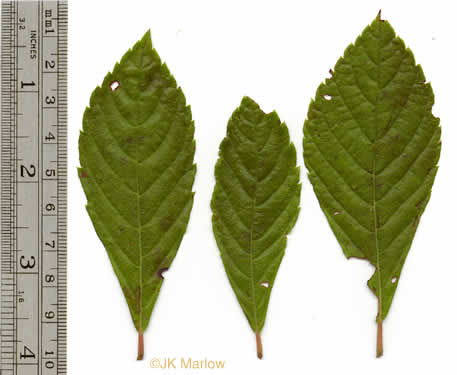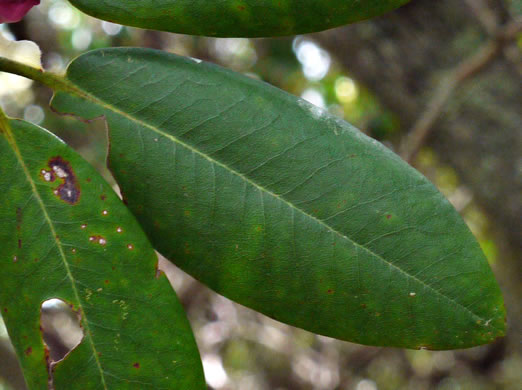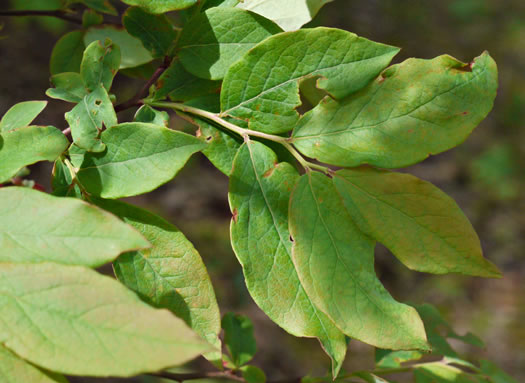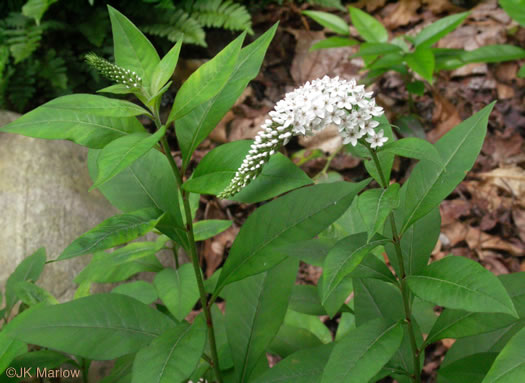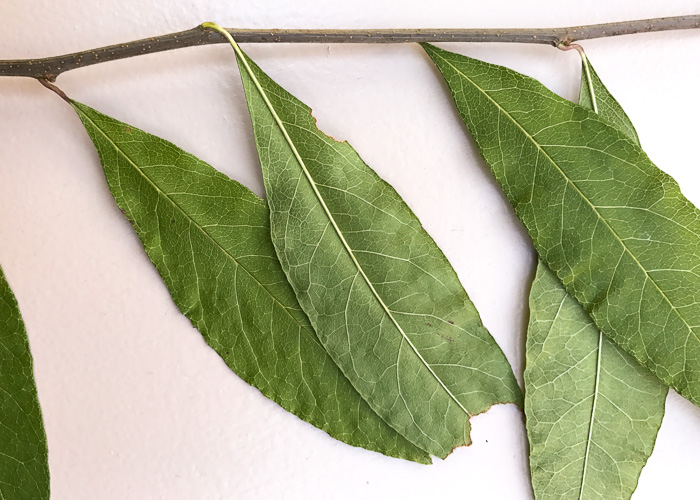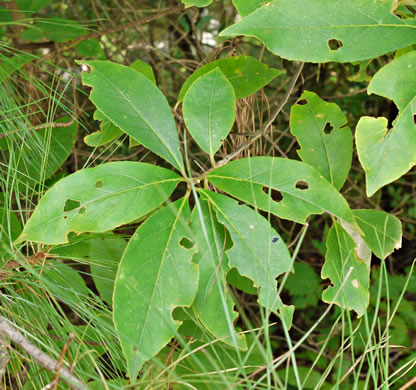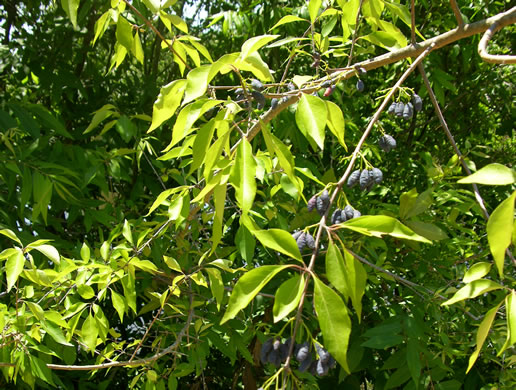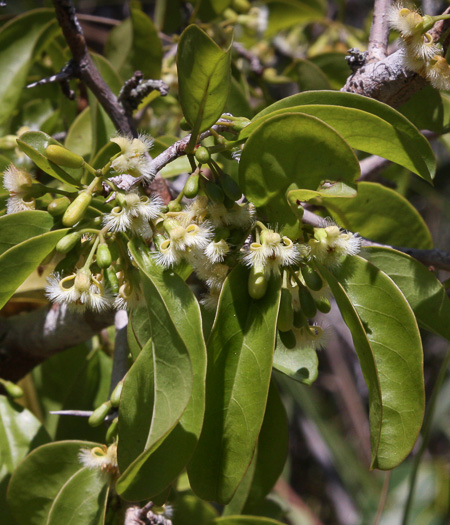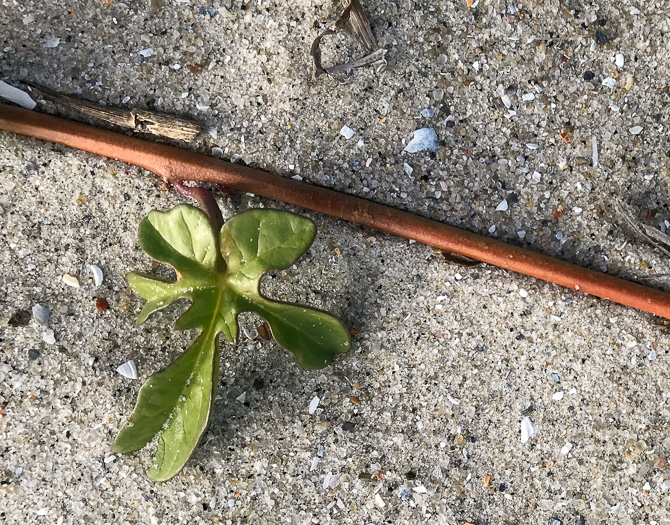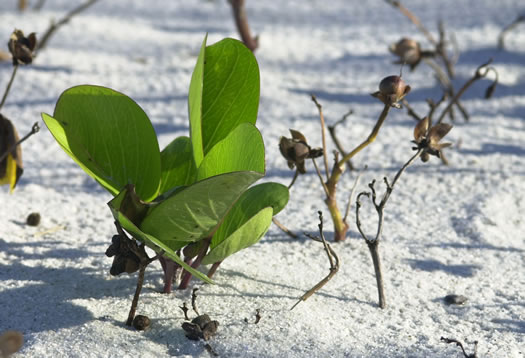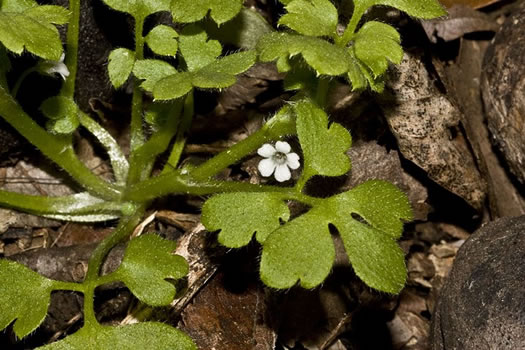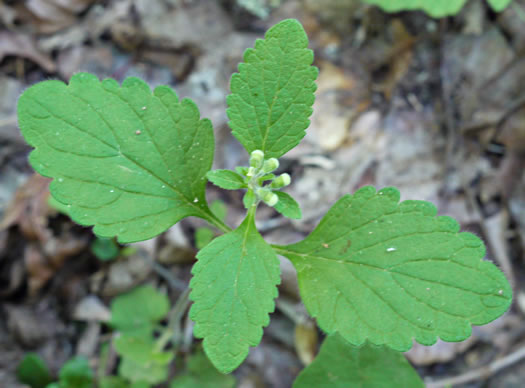Your search found 493 image(s) illustrating the term "blade." For a written explanation, click on "blade" in the Glossary.
PAGE 1 PAGE 2 PAGE 3 PAGE 4 PAGE 5 PAGE 6 PAGE 7 PAGE 8 PAGE 9
To see larger pictures, click or hover over the thumbnails.
To go to the plant's detail page, click its name.
 American Holly,
Ilex opaca
American Holly,
Ilex opaca
Leaf blades stiff, leathery, margins wavy to sharply spine-toothed, per Native Trees of the Southeast, An Identification Guide (Kirkman, Brown, & Leopold, 2007).
 Myrtle Holly,
Ilex myrtifolia
Myrtle Holly,
Ilex myrtifolia
Leaf blades linear or narrowly elliptical, bristle-tipped, margins revolute, per Native Trees of the Southeast, An Identification Guide (Kirkman, Brown, & Leopold, 2007).
 Possumhaw,
Ilex decidua
Possumhaw,
Ilex decidua
Leaf blades widest above the middle, bases wedge-shaped, margins undulate, per Native Trees of the Southeast, An Identification Guide (Kirkman, Brown, & Leopold, 2007).
 American Wahoo,
Euonymus atropurpureus
American Wahoo,
Euonymus atropurpureus
Leaf blades elliptical to ovate, 2-5" long, margins finely toothed, per Native Trees of the Southeast, An Identification Guide (Kirkman, Brown, & Leopold, 2007).
 Striped Maple,
Acer pensylvanicum
Striped Maple,
Acer pensylvanicum
Blades broadly 3-lobed, sinuses V-shaped, lobe tips long-pointed, per Native Trees of the Southeast, An Identification Guide (Kirkman, Brown, & Leopold, 2007).
 Sugar Maple,
Acer saccharum var. saccharum
Sugar Maple,
Acer saccharum var. saccharum
Blades 3-5" long, sinuses globose, lobe margins entire or wavy, per Native Trees of the Southeast, An Identification Guide (Kirkman, Brown, & Leopold, 2007).
 Southern Sugar Maple,
Acer floridanum
Southern Sugar Maple,
Acer floridanum
Leaf blades to 3.5" long. Upper surfaces dark green, lower whitish & hairy, per Native Trees of the Southeast, An Identification Guide (Kirkman, Brown, & Leopold, 2007).
 Common New Jersey Tea,
Ceanothus americanus var. americanus
Common New Jersey Tea,
Ceanothus americanus var. americanus
Flowers have 5 hooded petals, each with a 1mm blade & a narrow 1mm long claw, per Vascular Flora of the Carolinas (Radford, Ahles, & Bell, 1968).
 Carolina Buckthorn,
Frangula caroliniana
Carolina Buckthorn,
Frangula caroliniana
Leaf blades 4-6" long; parallel veins prominent, margins finely toothed, per Native Trees of the Southeast, An Identification Guide (Kirkman, Brown, & Leopold, 2007).
 Frost Grape,
Vitis vulpina
Frost Grape,
Vitis vulpina
Blades cordiform (deeply lobed leaves found only on ground shoots), per Upper Canopy Collection and Identification of Grapevines (Vitis) from Selected Forests in the Southeast US (Everhart, 2010).
 Arrowleaf Sida,
Sida rhombifolia var. rhombifolia
Arrowleaf Sida,
Sida rhombifolia var. rhombifolia
Leaf blade rhombic to oblong-lanceolate or obovate, rarely linear-lanceolate, per Flora of China.
 Okra,
Abelmoschus esculentus
Okra,
Abelmoschus esculentus
Leaf blade palmately 3-7 lobed, sparsely hirsute on both surfaces, per Flora of China.
 Upland Cotton,
Gossypium hirsutum
Upland Cotton,
Gossypium hirsutum
Leaf blade shallowly 3-5-lobed, lobes broadly ovate, base cordate, per Flora of North America.
 Mountain Camellia,
Stewartia ovata
Mountain Camellia,
Stewartia ovata
Leaf blades ovate to nearly elliptical, per Native Trees of the Southeast, An Identification Guide (Kirkman, Brown, & Leopold, 2007).
 Sandhills Birdsfoot Violet,
Viola pedata ssp. flabellata
Sandhills Birdsfoot Violet,
Viola pedata ssp. flabellata
Leaf blades incised only in distal half or only apically, per Weakley's Flora (2015).
 LeConte's Violet,
Viola affinis
LeConte's Violet,
Viola affinis
Largest leaf blades narrowly ovate-triangular, per Weakley's Flora (2023).
 Wavyleaf Violet,
Viola subsinuata var. subsinuata
Wavyleaf Violet,
Viola subsinuata var. subsinuata
Leaf blades biternately divided, secondary lobes of terminal primary division erect or spreading, per Weakley's Flora (2022).
 Wavyleaf Violet,
Viola subsinuata var. subsinuata
Wavyleaf Violet,
Viola subsinuata var. subsinuata
All leaf blades deeply divided (early ones NOT ovate, rotund, or cordate), per Weakley's Flora.
 Ovate-leaf Violet,
Viola fimbriatula
Ovate-leaf Violet,
Viola fimbriatula
Leaves are often angled upward, blades lanceolate, with convex margins, per Vascular Plants of North Carolina.
 Arrowleaf Violet,
Viola sagittata
Arrowleaf Violet,
Viola sagittata
Petioles equal or longer than blades, per Weakley's Flora.
 Arrowleaf Violet,
Viola sagittata
Arrowleaf Violet,
Viola sagittata
Blade outline narrowly ovate-triangular, much longer than wide, per Weakley's Flora.
 Southern Coastal Violet,
Viola septemloba
Southern Coastal Violet,
Viola septemloba
Blades and petioles mostly glabrous, unlike the similar-looking V. palmata, per Vascular Plants of North Carolina.
 Eggleston's Violet,
Viola egglestonii
Eggleston's Violet,
Viola egglestonii
Leaf blades about as broad as long, or broader, with 5-9 deep divisions, per Weakley's Flora.
 Wild White Violet,
Viola minuscula
Wild White Violet,
Viola minuscula
Leaf blades orbicular, mostly broadly rounded at apex, margins subentire to shallowly crenate, per Weakley's Flora (2023).
 Wild White Violet,
Viola minuscula
Wild White Violet,
Viola minuscula
Leaf blades strictly glabrous (petioles may be glabrous or pubescent), per Weakley's Flora (2023).
 Sweet White Violet,
Viola blanda
Sweet White Violet,
Viola blanda
Inner edges of basal lobes close or overlapping in life, sinus less than 1/4 length of blade, per Weakley's Flora (2023).
 Sweet White Violet,
Viola blanda
Sweet White Violet,
Viola blanda
Leaves glabrous except for scattered appressed hairs on upper surface of leaf blades, per Weakley's Flora (2023).
 Primrose-leaf Violet,
Viola primulifolia
Primrose-leaf Violet,
Viola primulifolia
Leaf blade tissue decurrent on the petiole, per Vascular Flora of the Carolinas (Radford, Ahles, & Bell, 1968).
 Lanceleaf Violet,
Viola lanceolata
Lanceleaf Violet,
Viola lanceolata
Leaf blades lanceolate, 3-8x long as wide; plant glabrous, per Weakley's Flora (2018).
 Strapleaf Violet,
Viola vittata
Strapleaf Violet,
Viola vittata
Leaf blades linear to linear-lanceolate, 8-15× as long as broad, tapering gradually to petiole, per Weakley's Flora (2022).
 Roundleaf Yellow Violet,
Viola rotundifolia
Roundleaf Yellow Violet,
Viola rotundifolia
Leaf blades rotund, per Weakley's Flora.
 Halberdleaf Violet,
Viola hastata
Halberdleaf Violet,
Viola hastata
Leaf blades hastate, distinctly longer than wide. Leaf bases strongly cordate, per Weakley's Flora.
 Downy Yellow Violet,
Viola pubescens
Downy Yellow Violet,
Viola pubescens
Foliage densely pubescent throughout; upper surface of leaf blade gray-green, per Weakley's Flora (2020).
 Walter's Violet,
Viola walteri
Walter's Violet,
Viola walteri
Leaf blades moderately to densely puberulent over entire surface, per Weakley's Flora.
 Appalachian Violet,
Viola appalachiensis
Appalachian Violet,
Viola appalachiensis
Leaf blades with scattered hairs near the margin only, per Weakley's Flora.
 Thorny Olive,
Elaeagnus pungens
Thorny Olive,
Elaeagnus pungens
Leaf undersides are silver with brown scales scattered on blade and midrib. — Clemson Extension
 Autumn-olive,
Elaeagnus umbellata
Autumn-olive,
Elaeagnus umbellata
Leaf blade adaxially sparsely scaly when young, per Flora of China.
 Common Water-purslane,
Ludwigia palustris
Common Water-purslane,
Ludwigia palustris
Leaf blade abruptly tapered to a winged stalk, per www.minnesotawildflowers.info.
 Common Water-purslane,
Ludwigia palustris
Common Water-purslane,
Ludwigia palustris
Each leaf is elliptical, entire, ~ 1" long and half as wide; the blade is attenuated to the stem, per Vascular Plants of North Carolina.
 Dune Pennywort,
Hydrocotyle bonariensis
Dune Pennywort,
Hydrocotyle bonariensis
Leaves (1-) 4-15cm wide, the blade characteristically held in a vertical plane, per Weakley's Flora (2025).
 Savanna Eryngo,
Eryngium integrifolium
Savanna Eryngo,
Eryngium integrifolium
Blades of basal leaves 3-7 (-10) cm long, acute to obtuse apically; margins lacking spiny tips, per Weakley's Flora (2024).
 Marsh-parsley,
Cyclospermum leptophyllum
Marsh-parsley,
Cyclospermum leptophyllum
Leaves petiolate; blade 3-4 pinnatisect; ultimate segments narrow, slender, per Flora of China.
 Sandhill Angelica,
Angelica dentata
Sandhill Angelica,
Angelica dentata
Leaflets with elliptic to lanceolate, incised or incised-serrate blades, per Manual of the Southeastern Flora (JK Small, 1933).
 Cowbane,
Oxypolis rigidior
Cowbane,
Oxypolis rigidior
Leaflets have few or no teeth (teeth, if any, above middle of leaflet blade), per Wildflowers of Tennessee (Carman, 2005).
 Alternate-leaf Dogwood,
Swida alternifolia
Alternate-leaf Dogwood,
Swida alternifolia
Leaf venation is arcuate, with main veins curving to follow blade margin, per Woody Plants of the Blue Ridge (Lance).
 Coastal Sweet-pepperbush,
Clethra alnifolia
Coastal Sweet-pepperbush,
Clethra alnifolia
Leaves sharply toothed (on upper half of blade), w parallel lateral veins, per Atlantic Coastal Plain Wildflowers (Nelson, 2006).
 Rosebay Rhododendron,
Rhododendron maximum
Rosebay Rhododendron,
Rhododendron maximum
Leaf blades leathery, oblong, 4-12" long, bases tapered, tips pointed, per Native Trees of the Southeast, An Identification Guide (Kirkman, Brown, & Leopold, 2007).
 Catawba Rhododendron,
Rhododendron catawbiense
Catawba Rhododendron,
Rhododendron catawbiense
Blades leathery, widely elliptical, 1/2-6" long; bases rounded, tips blunt, per Native Trees of the Southeast, An Identification Guide (Kirkman, Brown, & Leopold, 2007).
 Appalachian Deerberry,
Vaccinium stamineum var. 2
Appalachian Deerberry,
Vaccinium stamineum var. 2
Leaf blades often slightly wavy or arching, per Forest Plants of the Southeast and Their Wildlife Uses (Miller & Miller, 2005).
 Gooseneck Loosestrife,
Lysimachia clethroides
Gooseneck Loosestrife,
Lysimachia clethroides
Leaf blades broadly elliptic, broadly lanceolate, or broadly ovate, per Weakley's Flora.
 Northern Starflower,
Trientalis borealis
Northern Starflower,
Trientalis borealis
Distal leaf blades lanceolate to lanceolate-elliptic, widest at midlength, apex acute to acuminate, per Flora of North America.
 Buckthorn Bumelia,
Sideroxylon lycioides
Buckthorn Bumelia,
Sideroxylon lycioides
Upper surfaces of mature leaf blades notably finely reticulate-veined (at 20x), per Weakley's Flora.
 Horsesugar,
Symplocos tinctoria
Horsesugar,
Symplocos tinctoria
Mostly evergreen with thick, leathery leaf blades, per Native Shrubs and Woody Vines of the Southeast (Foote & Jones, 1989).
 Swamp Forestiera,
Forestiera acuminata
Swamp Forestiera,
Forestiera acuminata
Leaf blades oblong to diamond-shaped, tapering at both ends, per Native Trees of the Southeast, An Identification Guide (Kirkman, Brown, & Leopold, 2007).
 Tallow-wood,
Ximenia americana
Tallow-wood,
Ximenia americana
Leaf blades oblong to elliptic or nearly so; margins entire, per Manual of the Southeastern Flora (JK Small, 1933).
 Fiddleleaf Morning Glory,
Ipomoea imperati
Fiddleleaf Morning Glory,
Ipomoea imperati
Most leaf blades lobed at the base, often deeply so, per Guide to the Wildflowers of SC, 1st ed. (Porcher & Rayner, 2001).
 Coastal Morning Glory,
Ipomoea cordatotriloba var. cordatotriloba
Coastal Morning Glory,
Ipomoea cordatotriloba var. cordatotriloba
"Corda" refers to heartshaped lf bases; "triloba" to mostly 3-lobed blades, per Atlantic Coastal Plain Wildflowers (Nelson, 2006).
 Railroad Vine,
Ipomoea brasiliensis
Railroad Vine,
Ipomoea brasiliensis
Leaf blades unlobed but summit notched, per Wildflowers of the Eastern United States (Duncan & Duncan, 1999).
 Baby Blue Eyes,
Nemophila aphylla
Baby Blue Eyes,
Nemophila aphylla
Leaves are long-stalked with blade deeply divided into 3-5 lobes, per Wildflowers of Tennessee (Carman, 2005).
 Hairy Skullcap,
Scutellaria elliptica var. elliptica
Hairy Skullcap,
Scutellaria elliptica var. elliptica
Stems pubescent. Petioles usually obscured by decurrent blade tissue, per Vascular Flora of the Carolinas (Radford, Ahles, & Bell, 1968).

